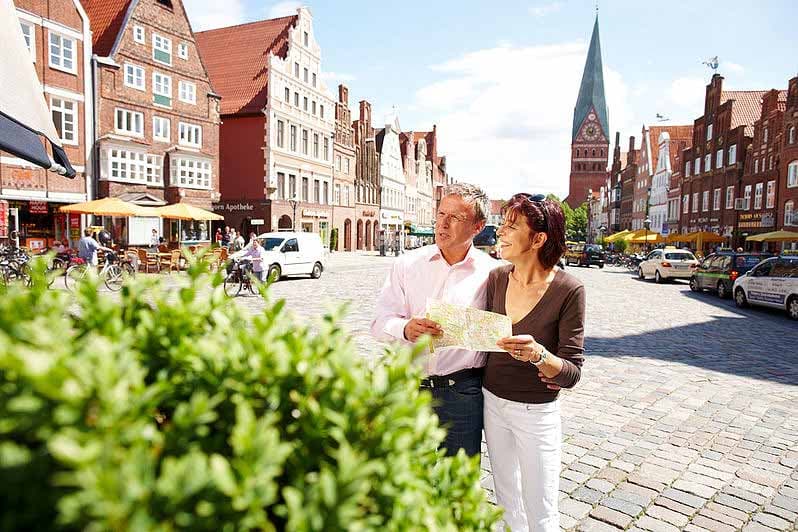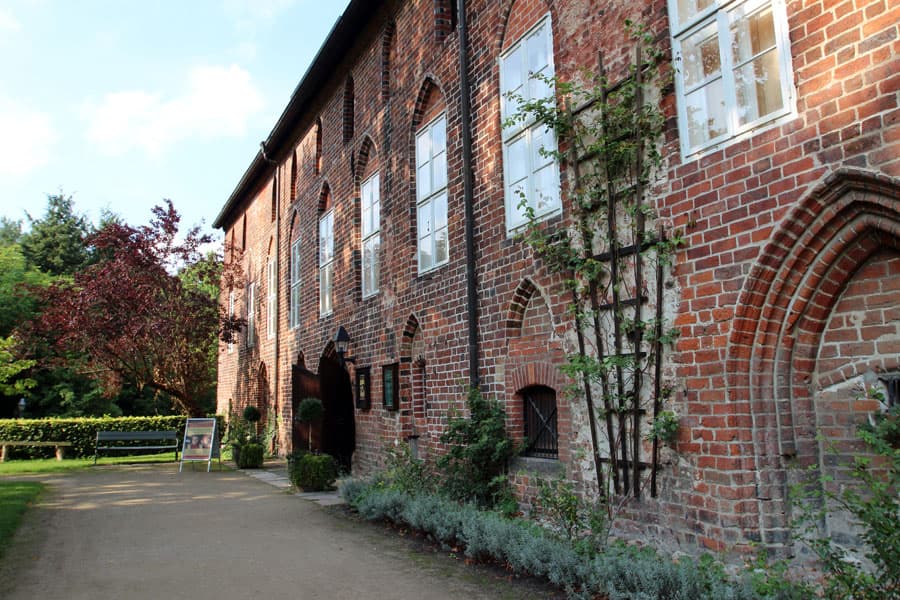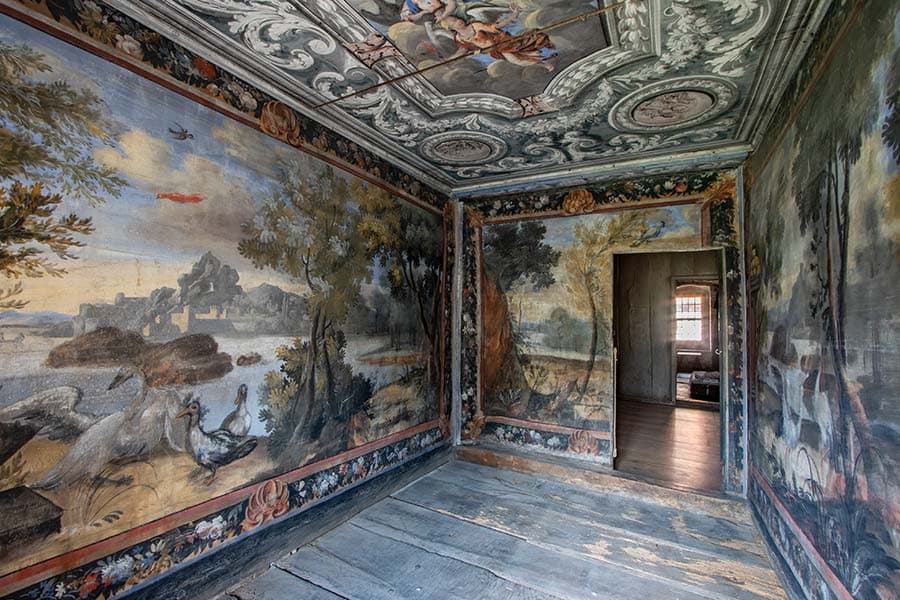
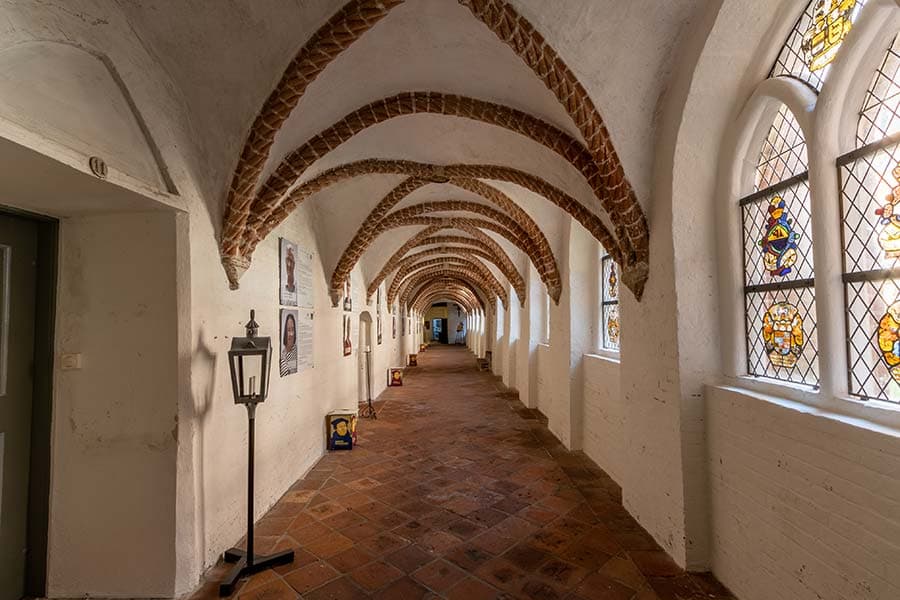
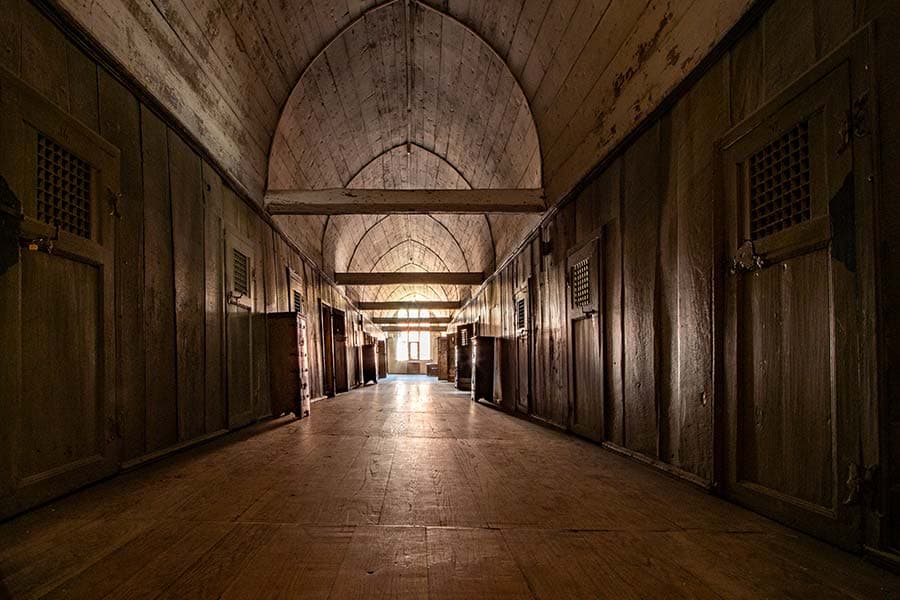
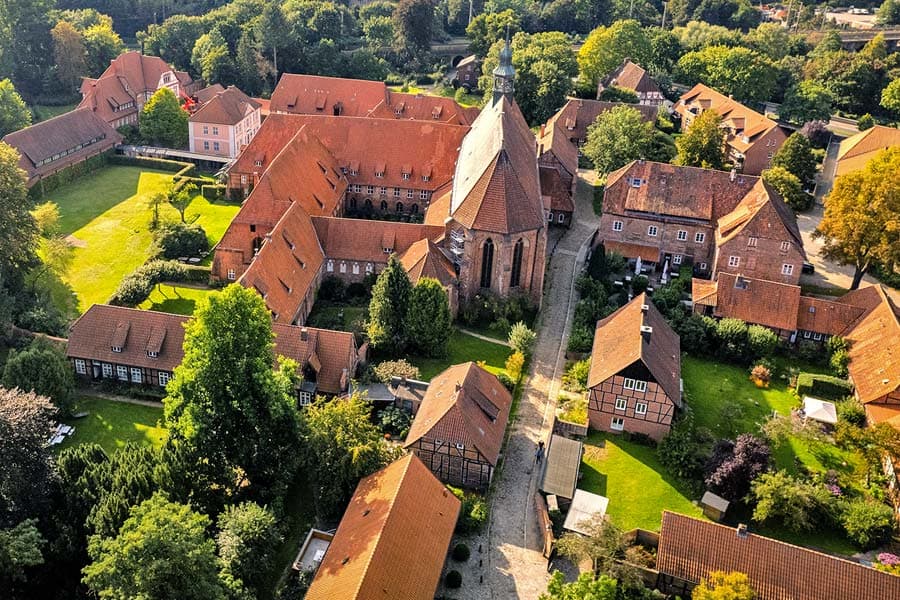
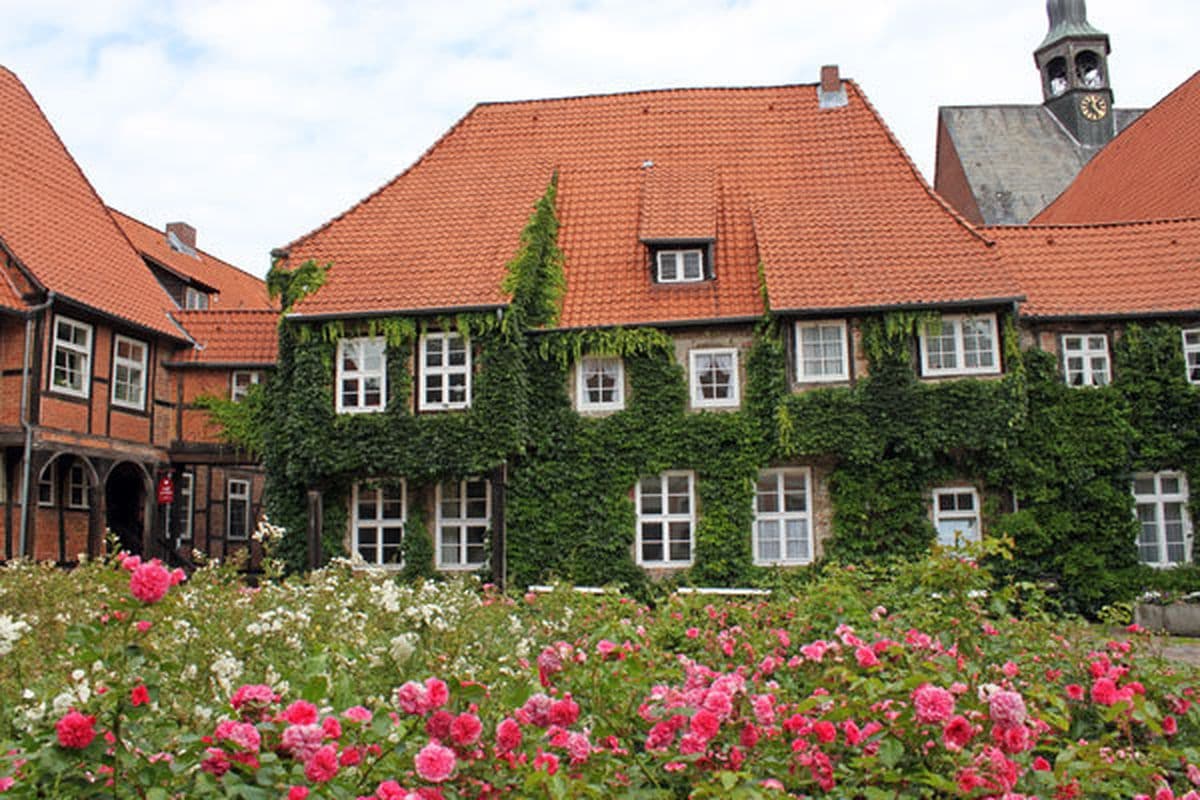
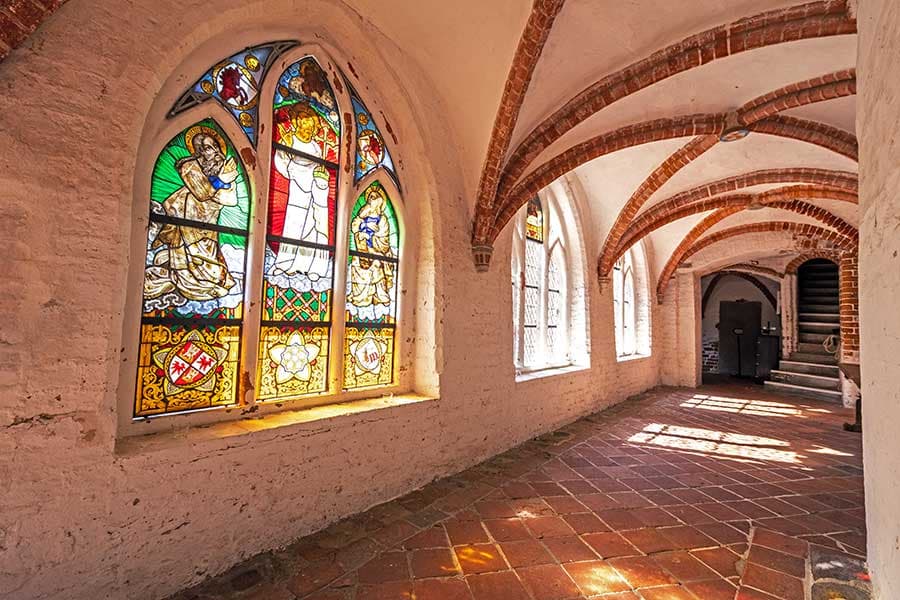
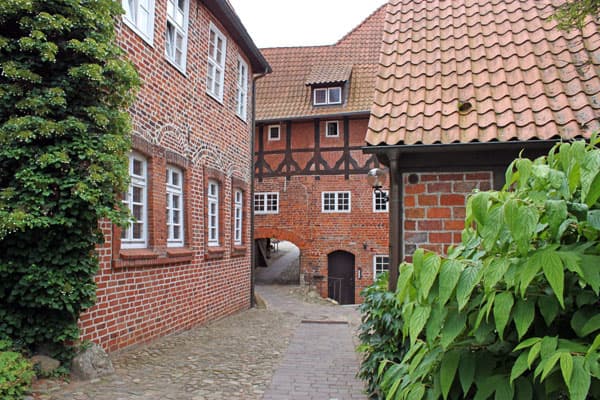
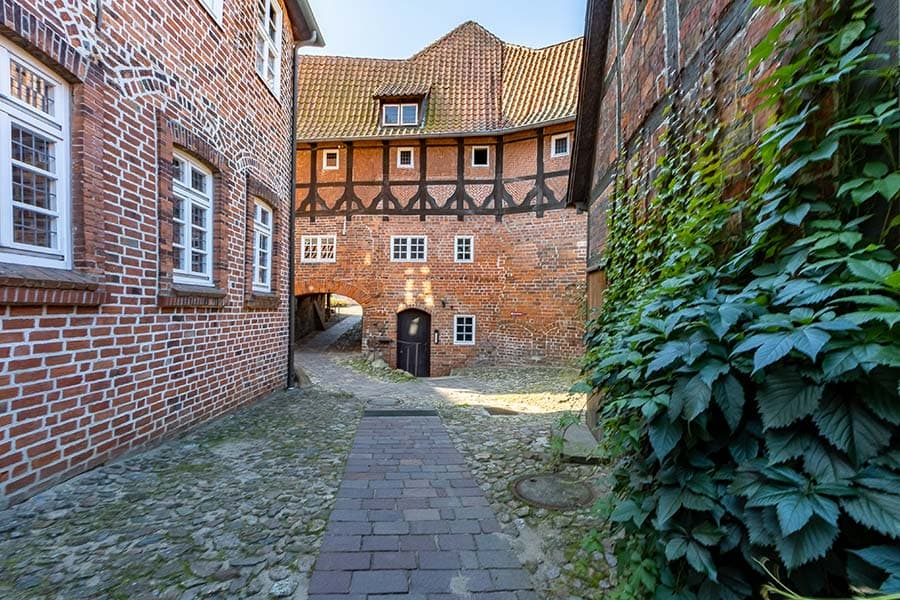
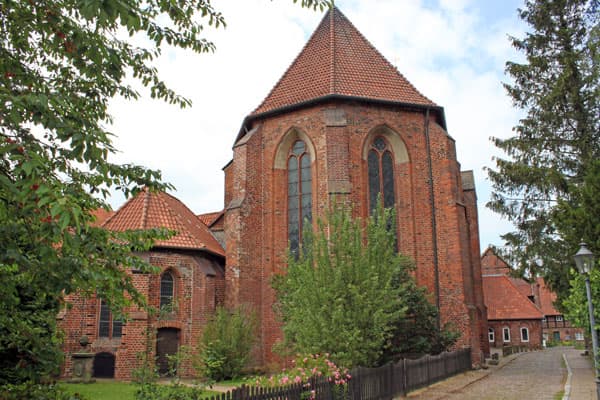
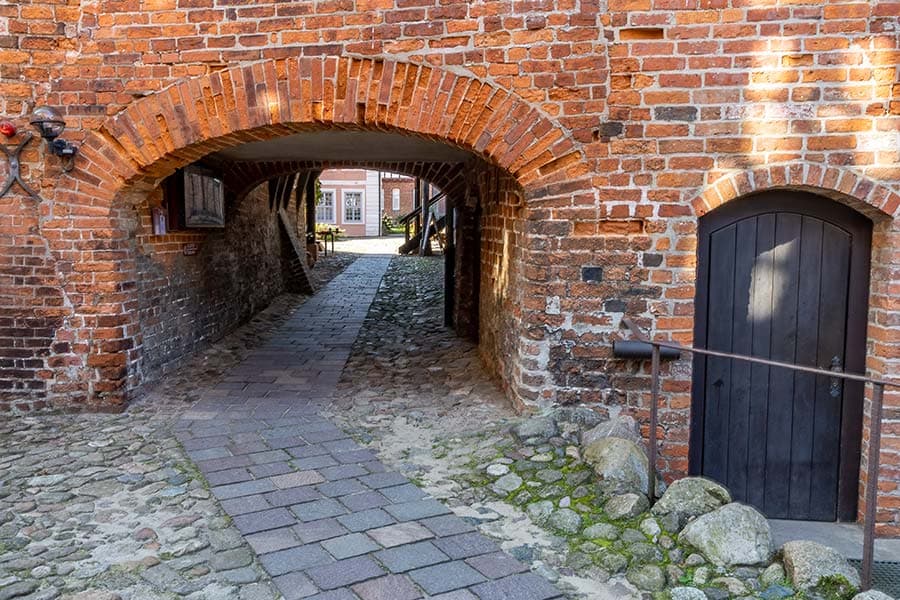
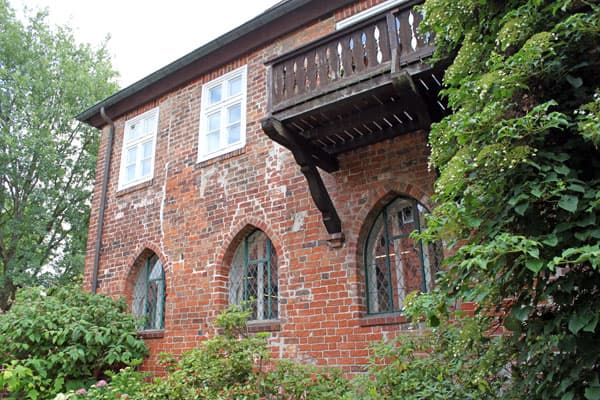
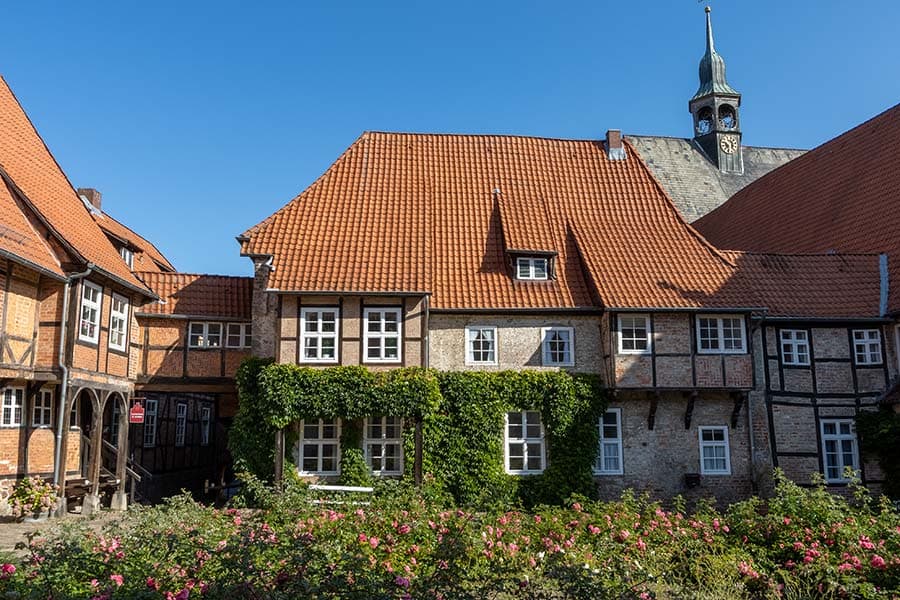
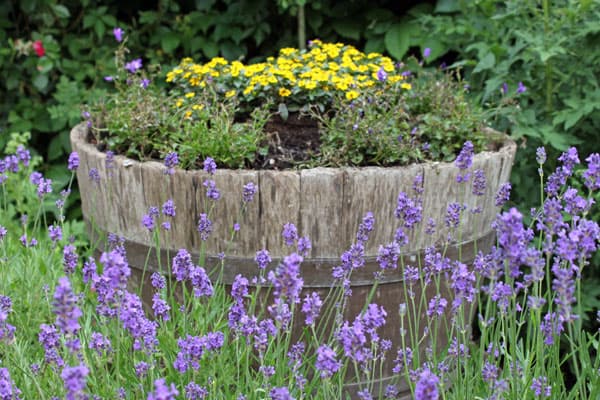
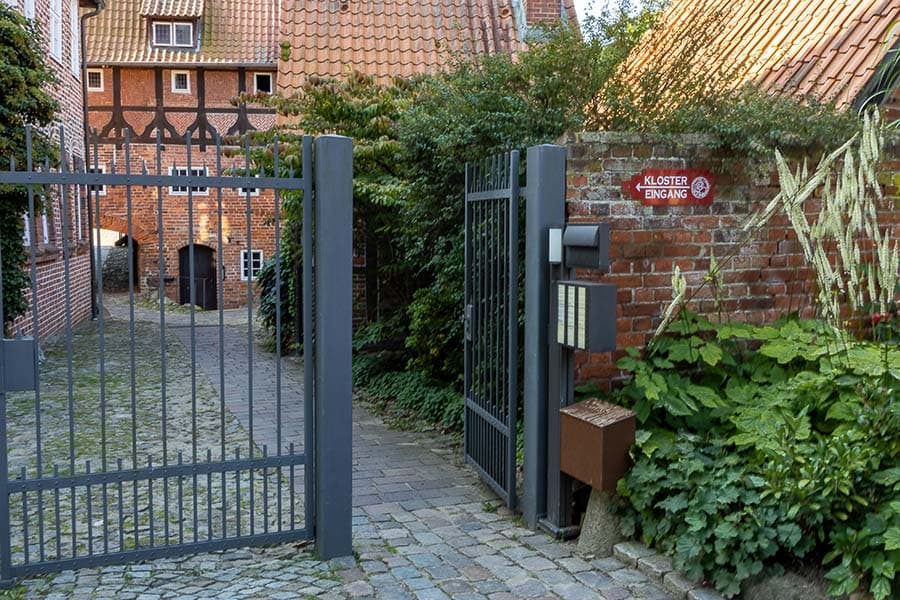
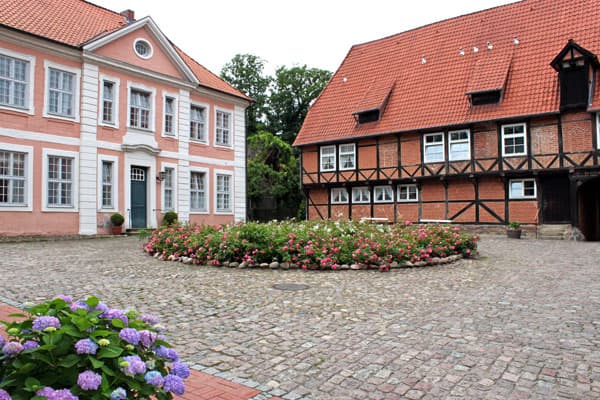
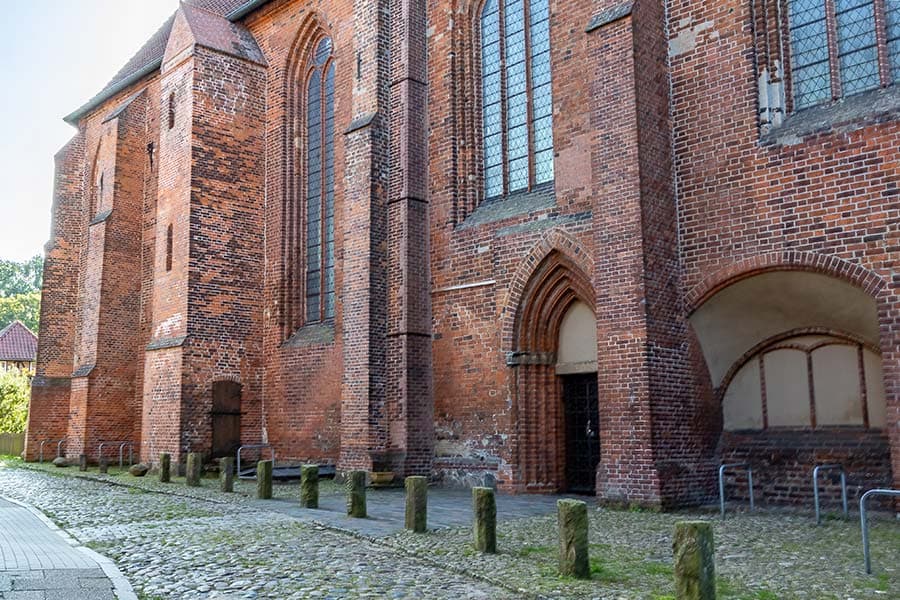
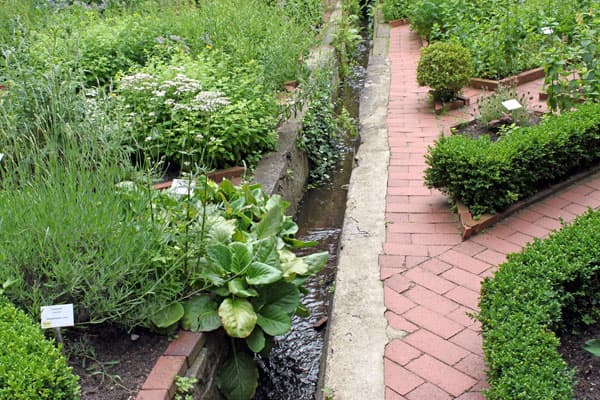
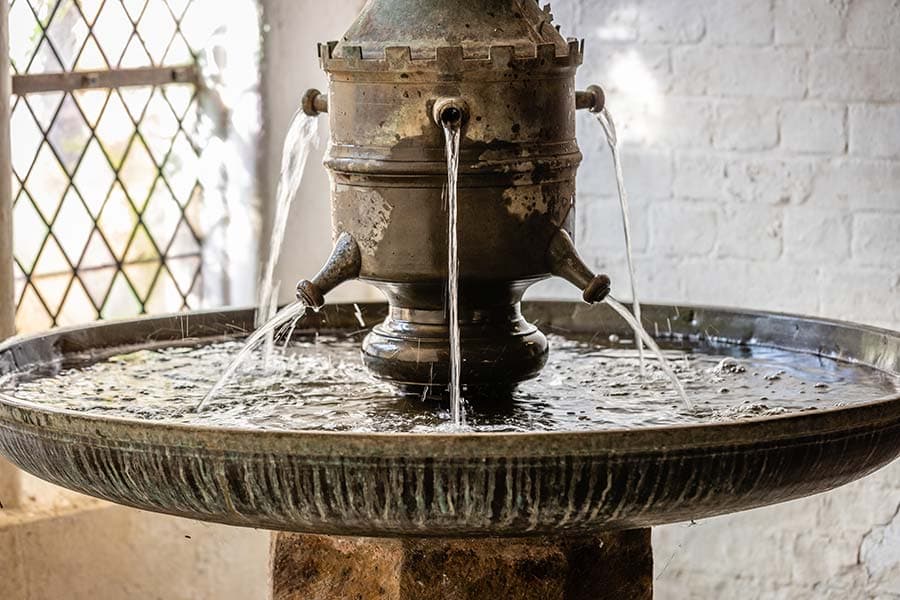
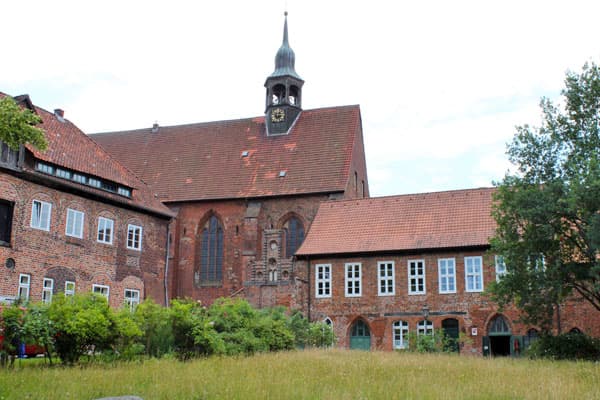
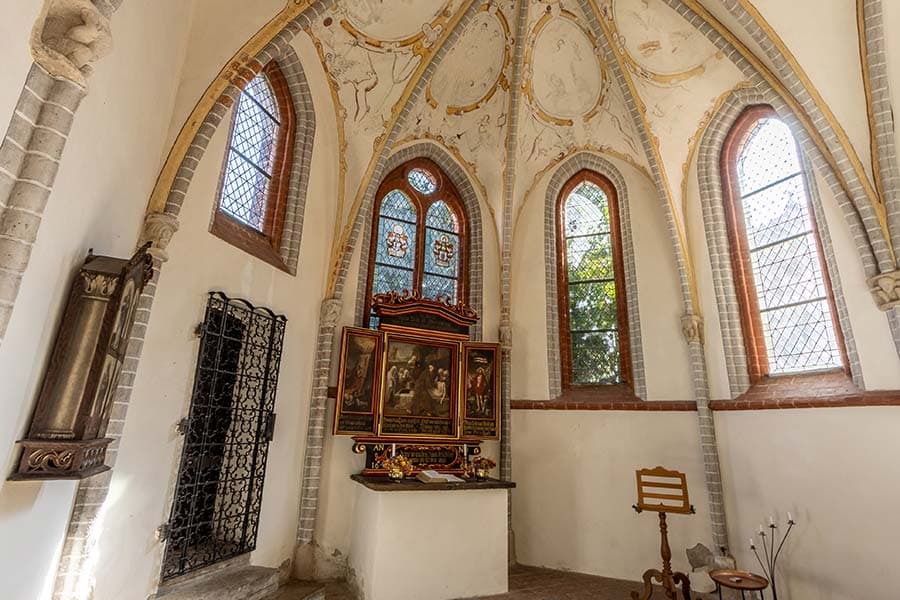
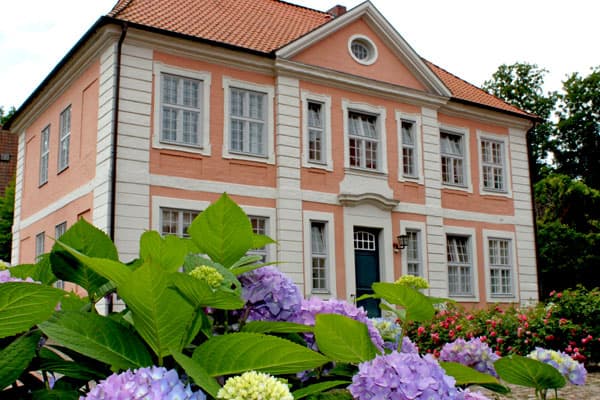
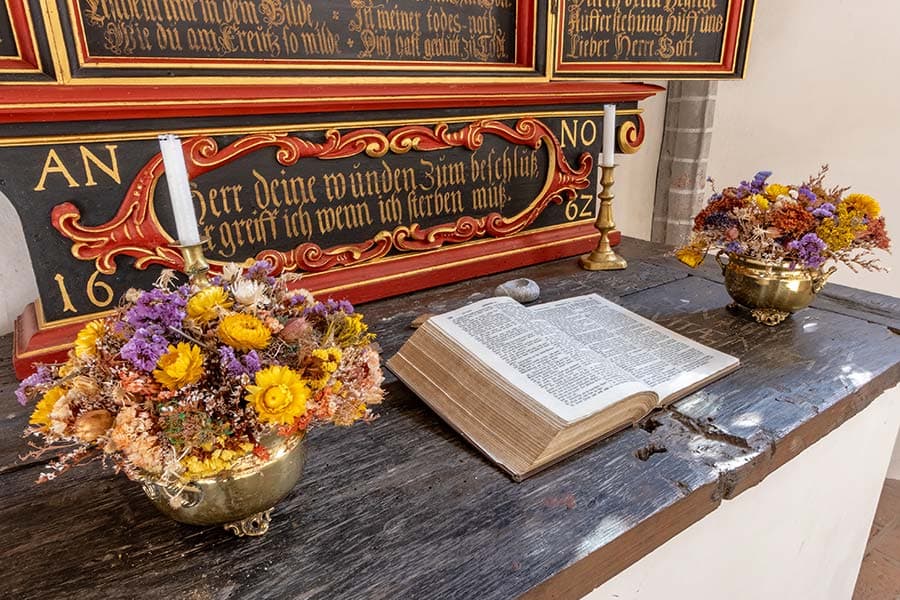
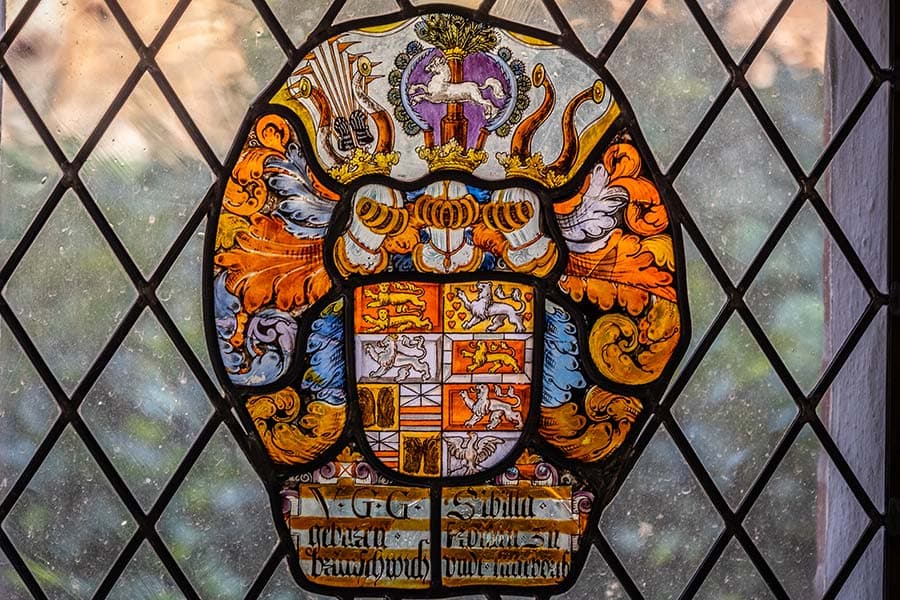
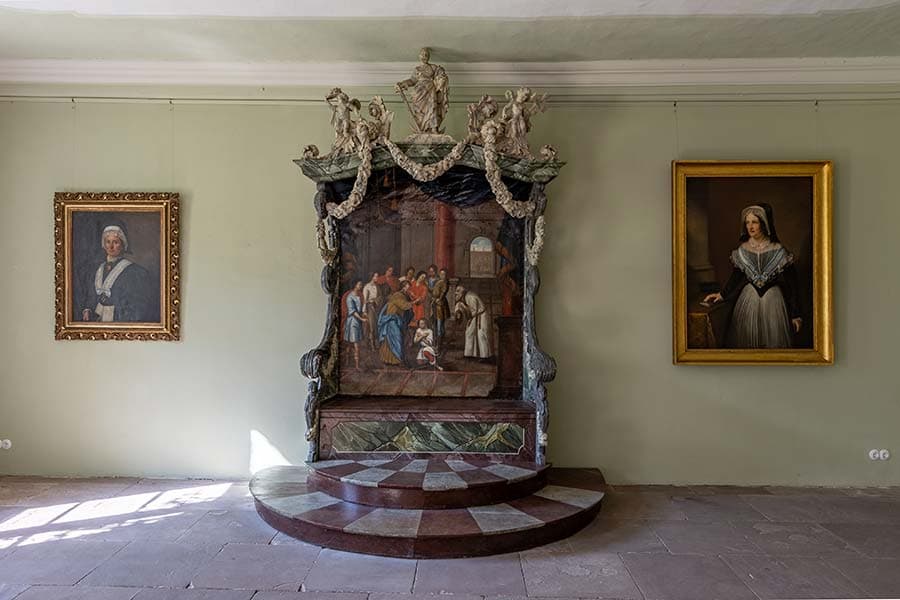
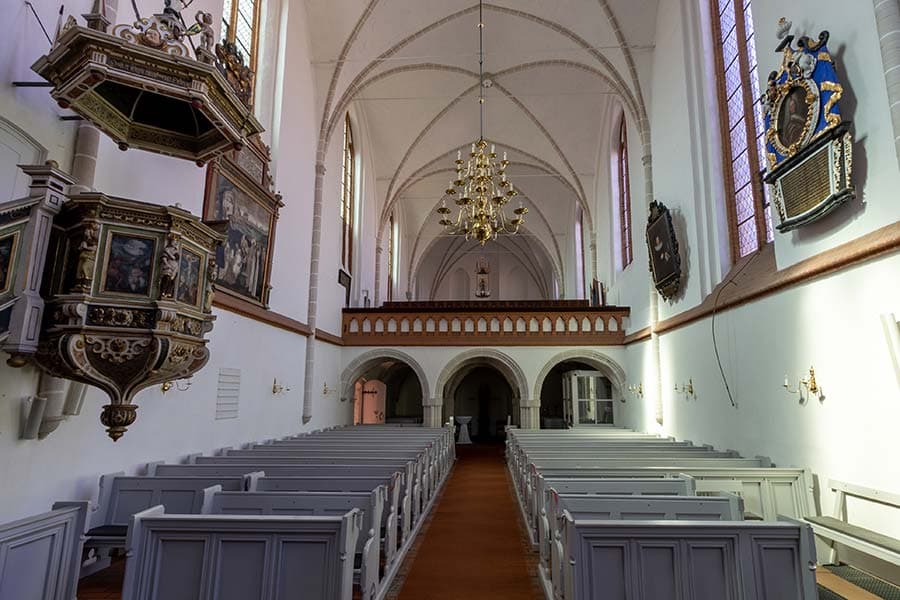
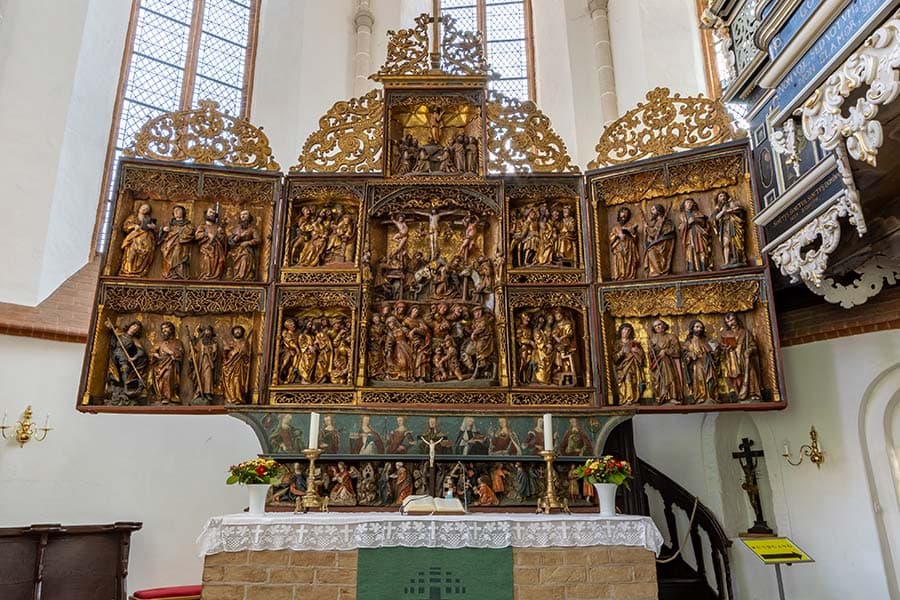
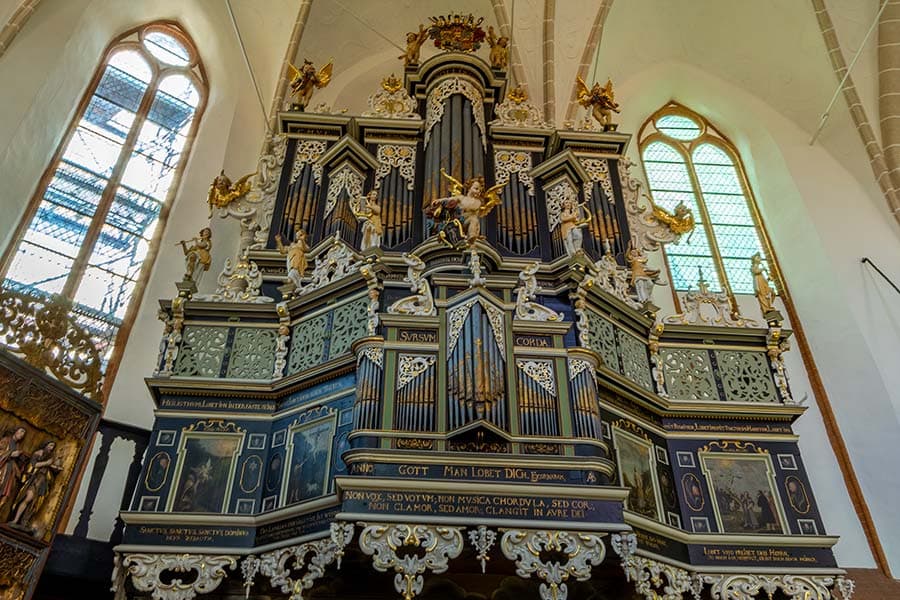
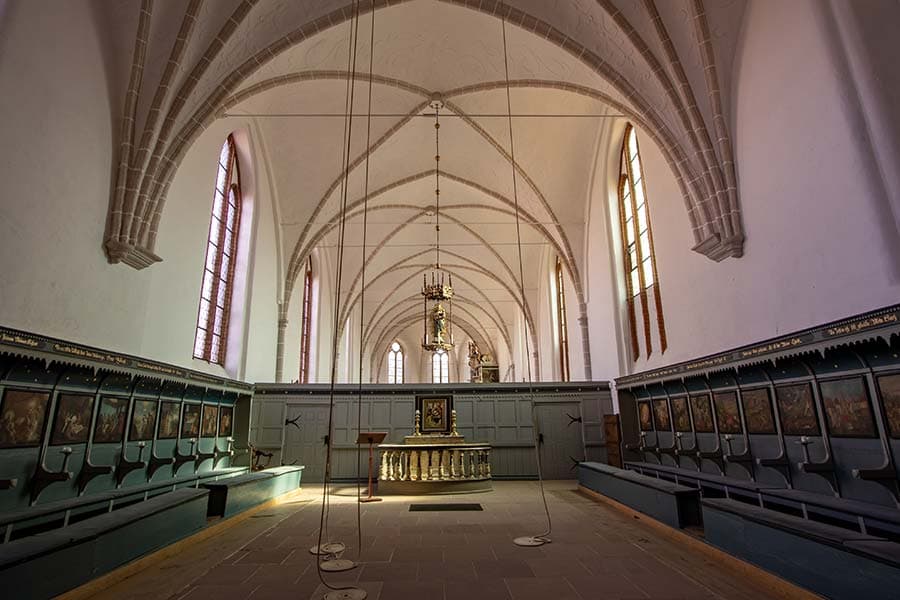
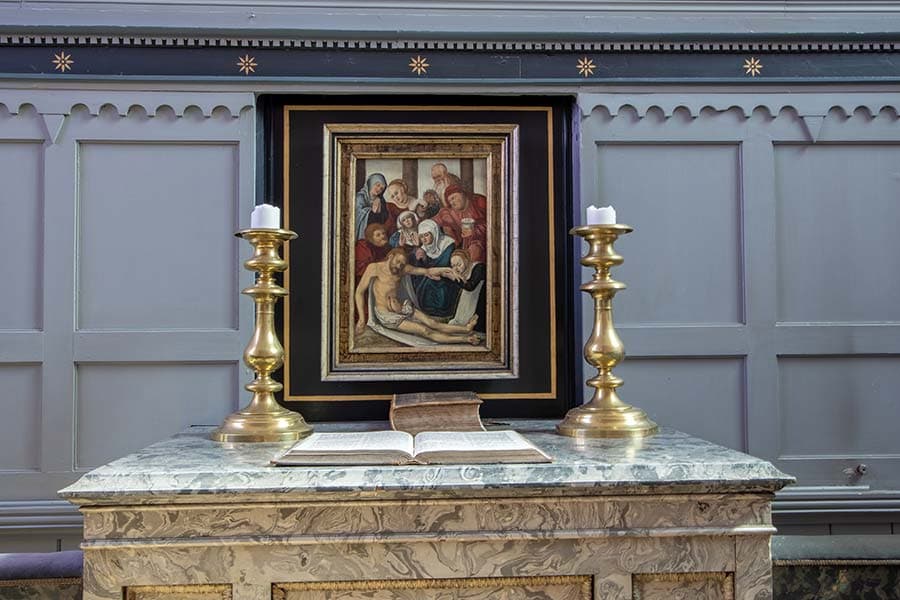
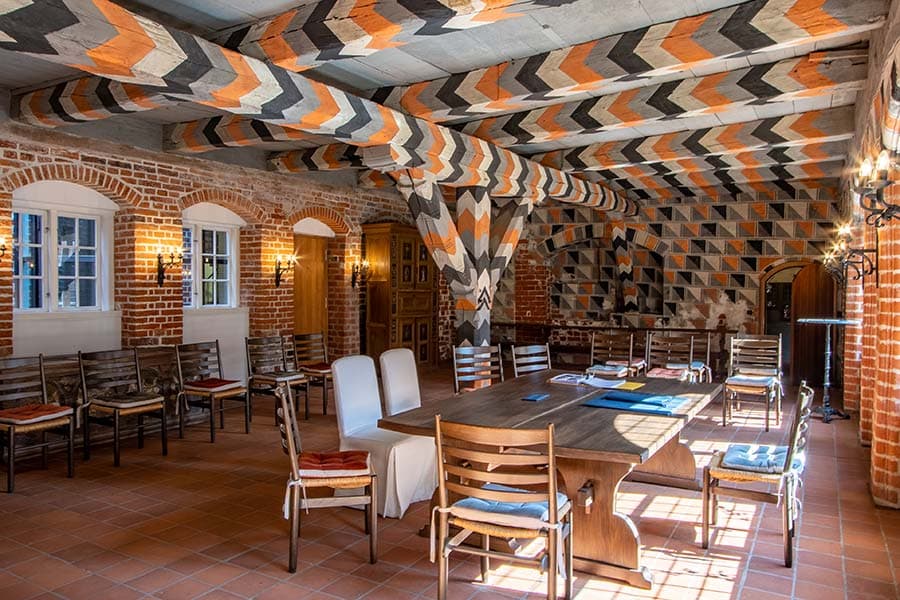
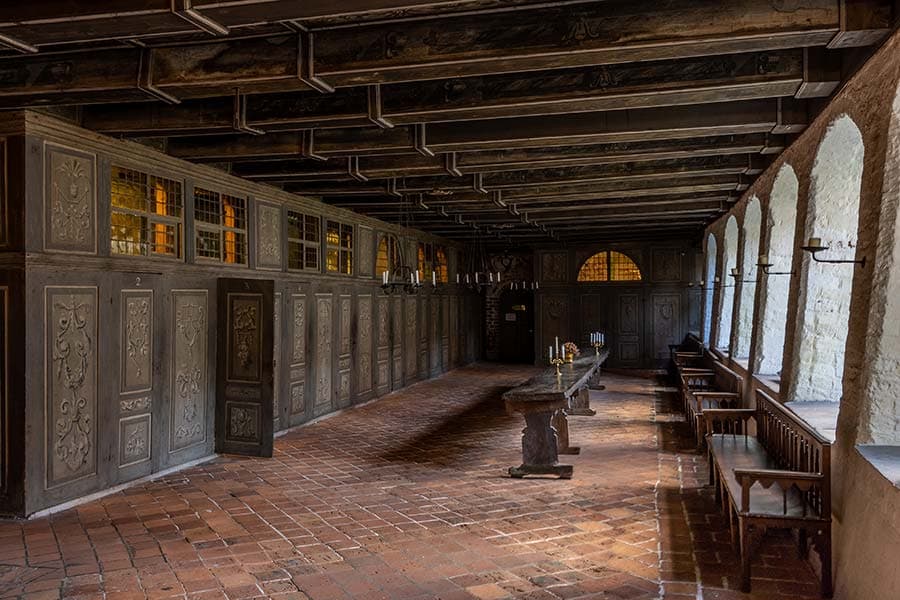
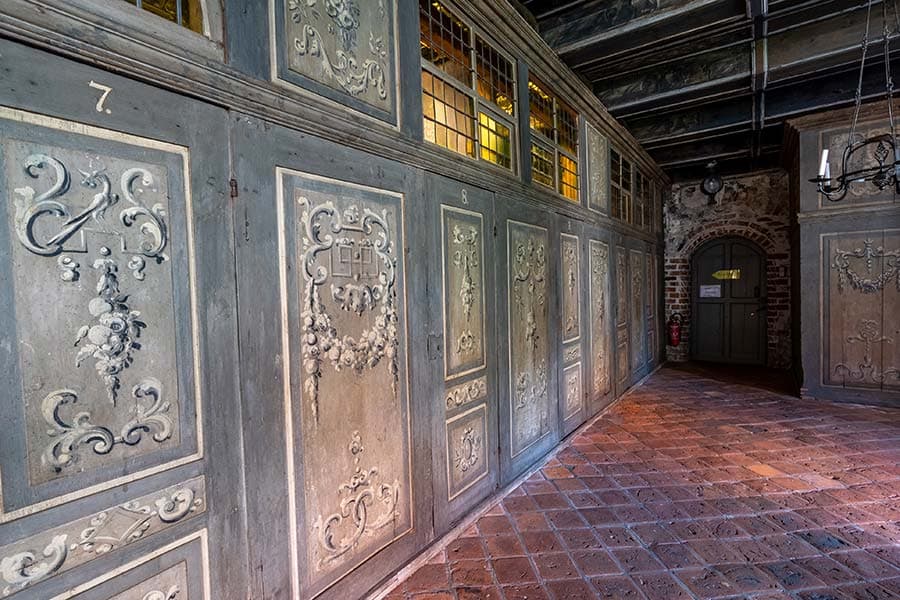
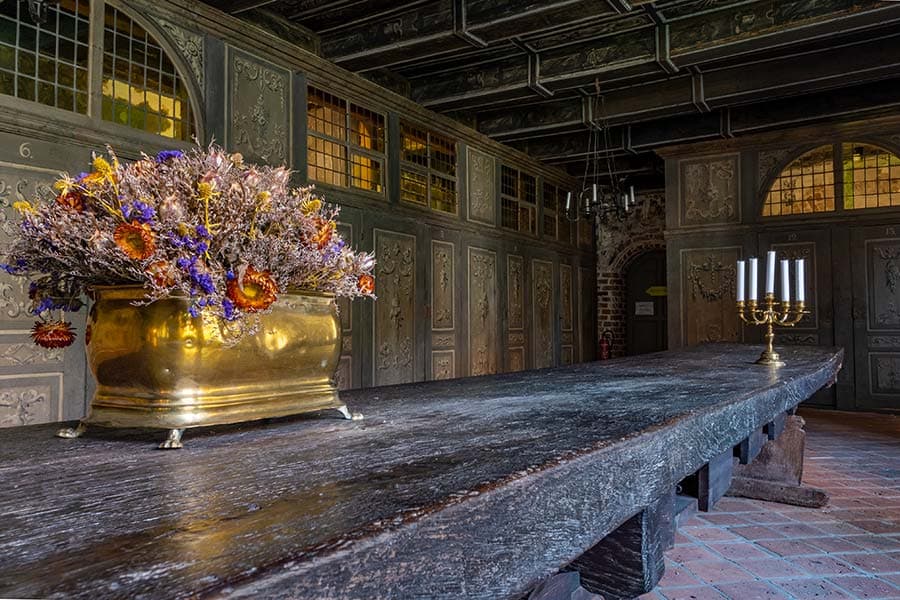
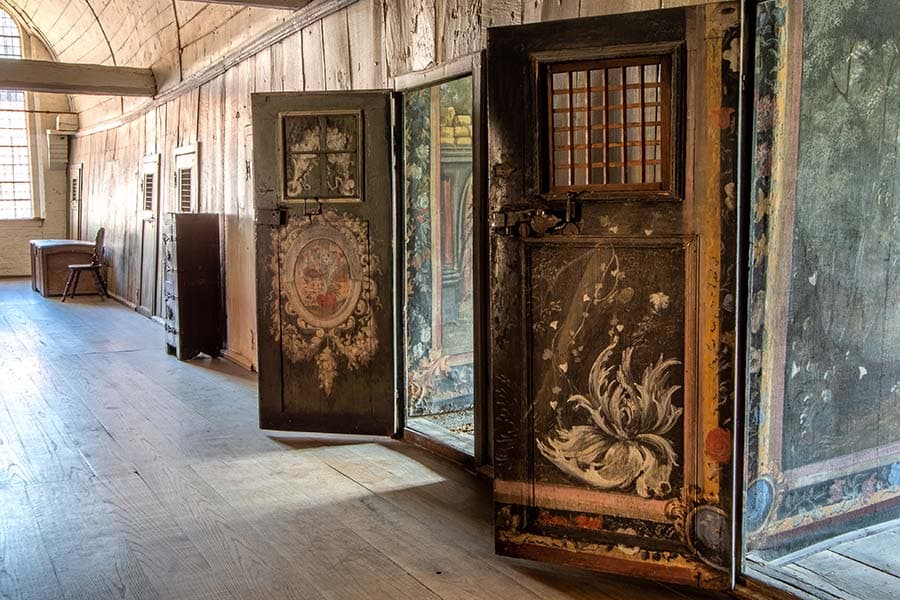
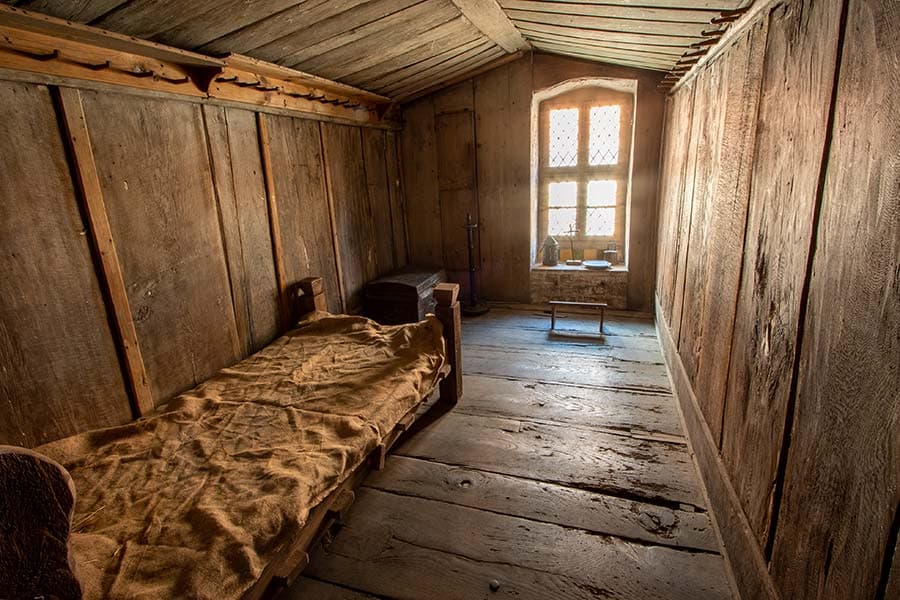
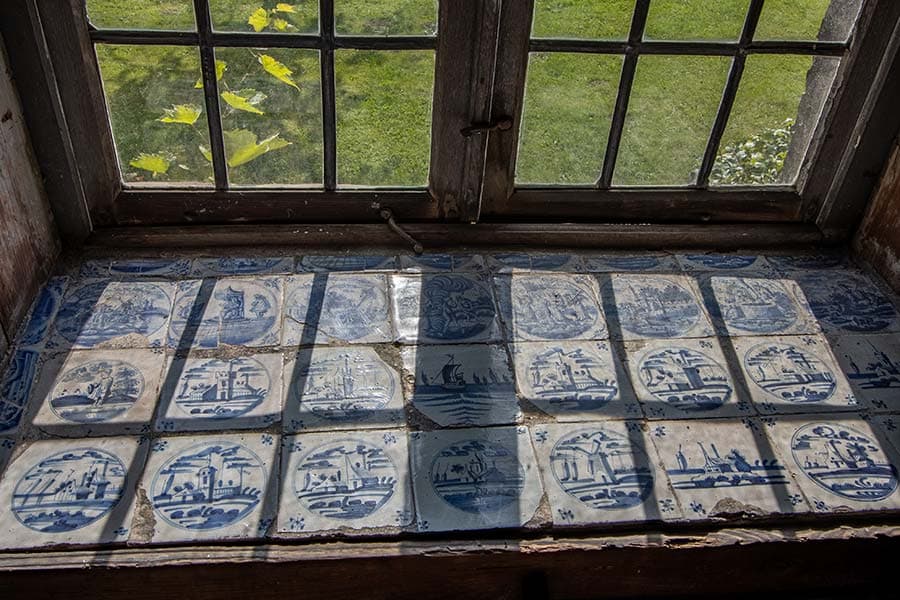
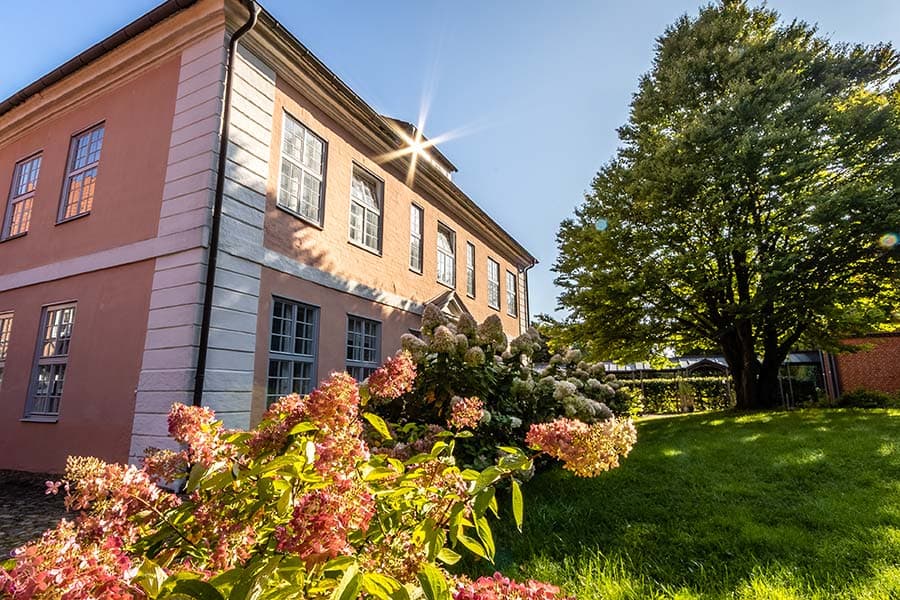
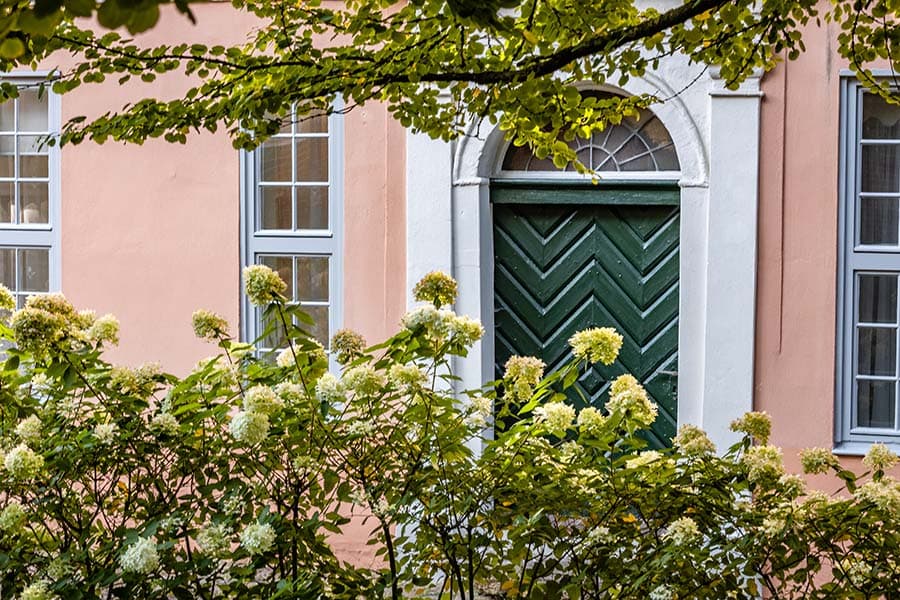
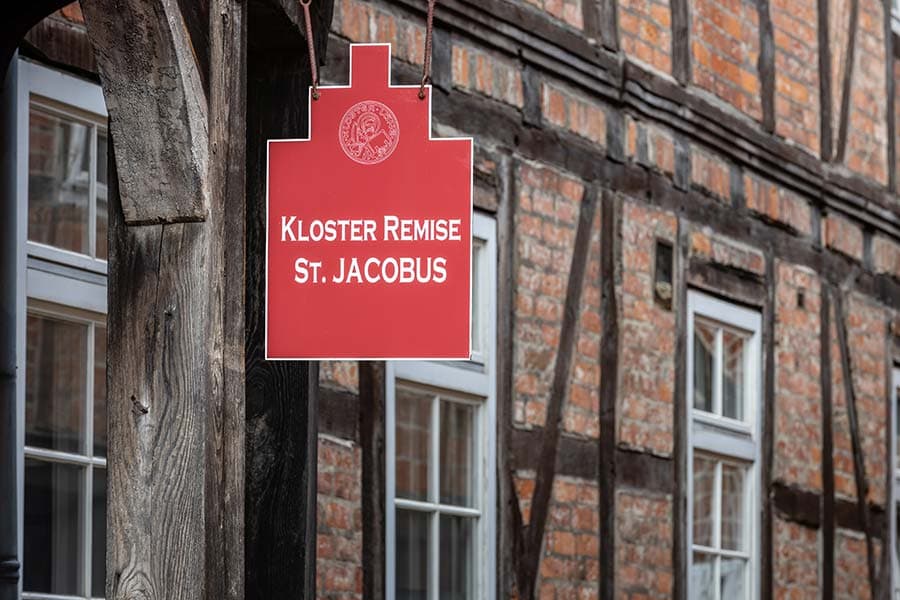
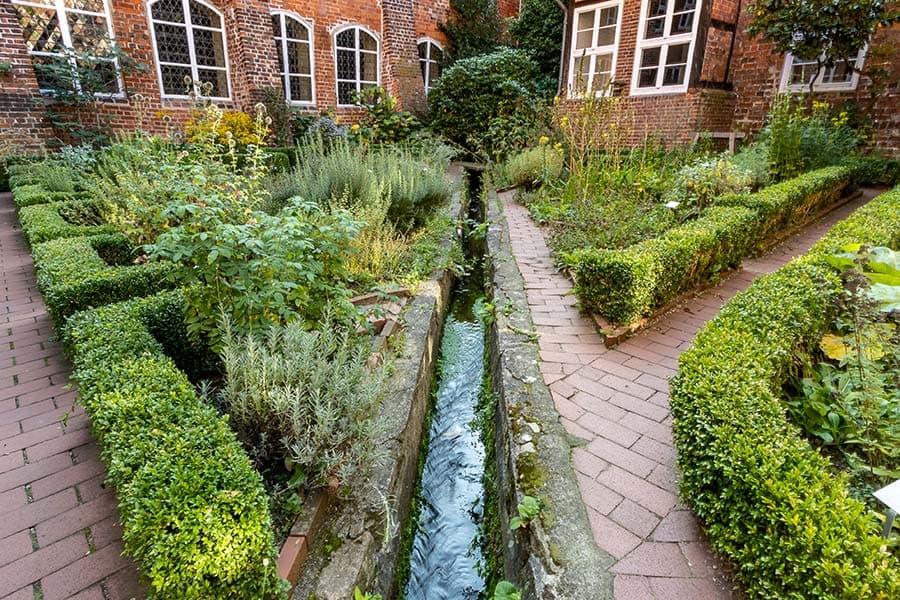
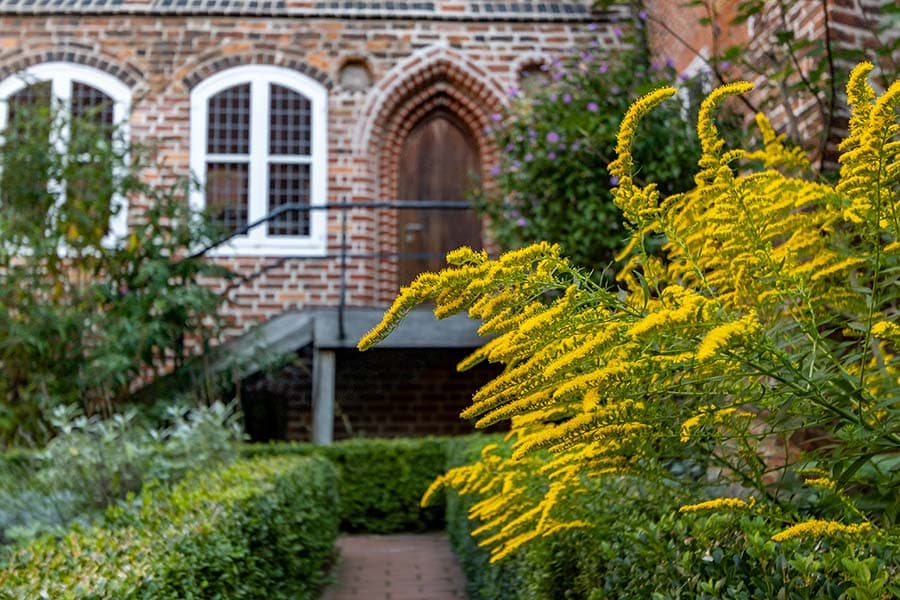
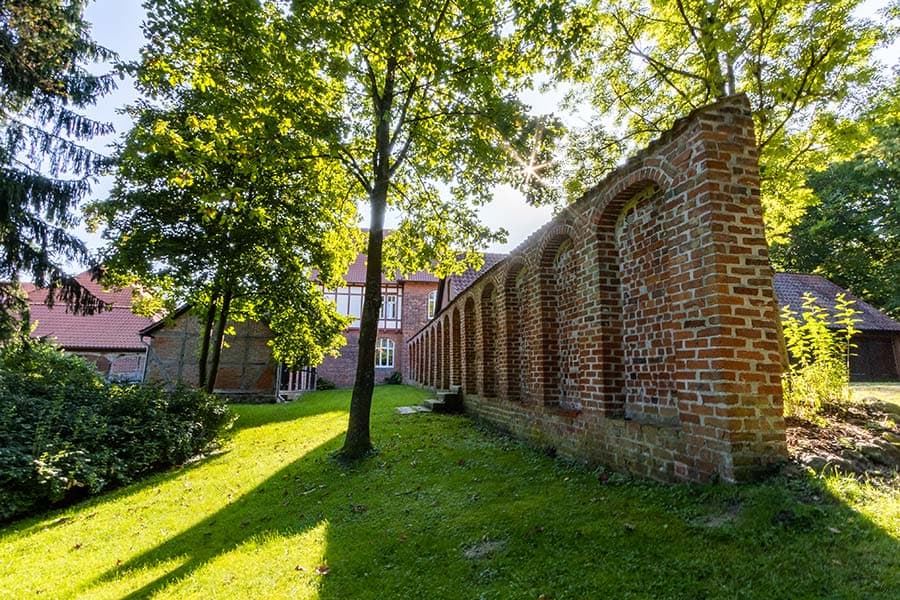
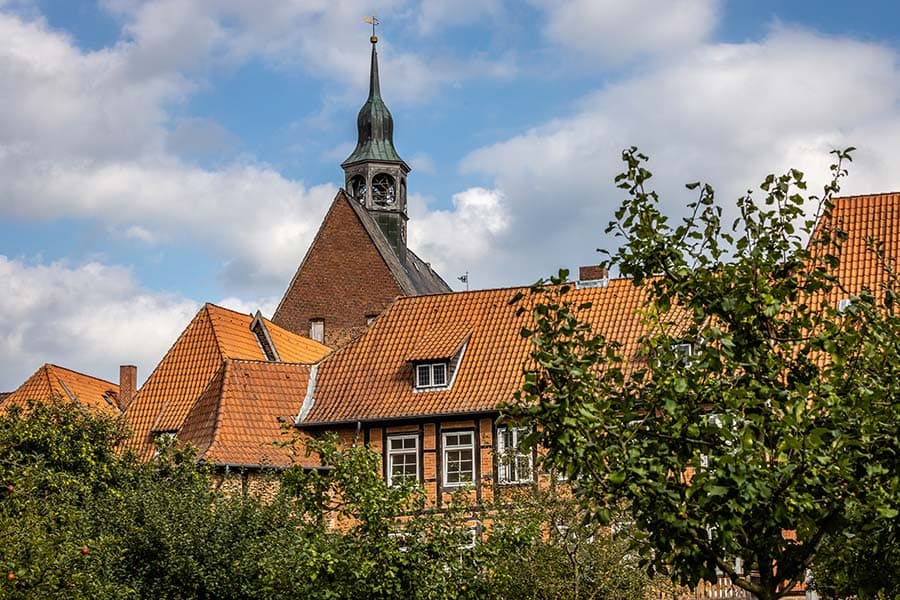
Betreten Sie das Kloster Lüne am Rande von Lüneburg und tauchen Sie ein in eine andere Welt. Fernab der städtischen Hektik erwartet Sie ein fast 850 Jahre altes Frauenkloster, das mit seiner beeindruckenden Geschichte, den malerischen Gärten und wertvollen Kunstschätzen Besucher in seinen Bann zieht. Dieser Beitrag nimmt Sie mit auf eine Entdeckungsreise durch die historischen Mauern und gibt Ihnen einen Einblick in die Besonderheiten dieses einzigartigen Ortes.
Ein Märchenhafter Empfang: Der Innenhof des Klosters Lüne
Man fühlt sich tatsächlich wie in einer anderen Welt, wenn man das Kloster Lüne betritt. Durch einen unscheinbaren Eingang gelangt man in einen Gang und findet sich plötzlich in einem Hof wieder, der einer Märchenerzählung entsprungen sein könnte. Blühende Rosen und sattes Efeu bilden einen reizvollen Kontrast zu den roten Backsteinen und dem traditionellen Fachwerk der Klostergebäude.
Die Lange Geschichte des Klosters Lüne: Mehr als 850 Jahre gelebte Tradition
Das Kloster Lüne in Lüneburg ist ein sehr eindrucksvolles Frauenkloster, das seit seiner Gründung im Jahr 1172 fast ununterbrochen bewohnt ist. Die Erlaubnis zur Gründung erteilte der Verdener Bischof frommen Frauen. Ab 1272 lebte der Konvent nach den Regeln des heiligen Benedikt. Im Laufe der Jahrhunderte wurde das Kloster mehrmals erweitert. Da es seit 1372 unzerstört blieb, präsentiert es sich heute noch in seiner historischen Bausubstanz.
Nach einem verheerenden Brand im Jahr 1372 wurde das Kloster Lüne rasch wieder aufgebaut. Bereits 1420 erstrahlten die Klosterkirche und das Klausurviereck in der charakteristischen Backsteingotik, die bis heute erhalten ist. Das Kloster verfügte über beträchtliche Mittel, nicht zuletzt durch seinen bedeutenden Anteil an der Lüneburger Saline.
Die Reformation stellte das Kloster vor eine Herausforderung. Über 50 Jahre lang weigerten sich die Klosterfrauen, den neuen Glauben des Landesherren Herzog Ernst "des Bekenners" anzunehmen. Möglicherweise spielte dabei auch die angespannte finanzielle Situation des Herzogs eine Rolle, der an den wertvollen Klostergütern interessiert gewesen sein könnte. Erst in der Mitte des 17. Jahrhunderts entwickelte sich eine tief verwurzelte evangelische Frömmigkeit im Kloster.
Bis ins 20. Jahrhundert hinein diente das Kloster Lüne als standesgemäße Einrichtung für unverheiratete Töchter des Adels und der Ritterschaft. Bis zu 60 Klosterfrauen lebten hier in Lüneburg. Heute wird das Kloster von neun selbstständigen Damen bewohnt, die die evangelisch-klösterliche Tradition lebendig halten.
Architektonische Schätze und Kunstwerke: Ein Rundgang durch das Kloster
Ein Rundgang oder eine Führung durch das Kloster Lüne umgibt Besucher mit einer besonderen Atmosphäre, die ein Eintauchen in die bewegte Geschichte dieses Ortes ermöglicht.
Der Gotische Brunnen: Ein Denkmal der Zeit
Beim Betreten des Klosters fällt der Blick zunächst auf den gotischen Brunnen, dessen Wasser seit über sechs Jahrhunderten unaufhörlich in die steinerne Schale fließt.
Der Kreuzgang: Farbige Fenster und Stille
Der anschließende Kreuzgang bildet das traditionelle Herzstück eines jeden Klosters. Hier sind die zahlreichen Glasmalereien aus dem 15. Jahrhundert besonders bewundernswert, deren farbiges Licht eine andächtige Stimmung erzeugt.
Der Kapitelsaal: Zeugnisse der Äbtissinnen und königlicher Besuch
Der Kapitelsaal diente den Klosterfrauen als zentraler Versammlungsort. Hier befindet sich die beeindruckende Galerie der Äbtissinnenporträts, die von 1580 bis heute vollständig ist. Ebenfalls zu sehen sind der prächtige Äbtissinnen-Thron und das Krönungsportrait Georgs II., König von England und Kurfürst von Hannover, der 1729 in diesem Raum empfangen wurde. Um ihn standesgemäß unterzubringen, wurde das rosa Barockhaus inmitten des Klosters errichtet.
Sommer- und Winterremter: Geschichte in bemalten Balken und kühlen Mauern
Das Sommer-Refektorium, auch Sommerremter genannt, beeindruckt mit seinem markant bemalten Balkenwerk, das in den 1980er Jahren vollständig restauriert wurde und die ungewöhnliche Farbgebung des Jahres 1482 widerspiegelt. Heute dient dieser Raum auch für Trauungen. Gleich nebenan befindet sich das Winter-Refektorium, der Winterremter, ein dunkler und kühler Raum, der Ehrfurcht einflößt. An der linken Seite sind die bemalten Speisekammern der Klosterdamen zu sehen, deren Bemalung erst oberhalb der üblichen Lagerhöhe beginnt und Einblicke in das stille Leben der Klosterfrauen während der Mahlzeiten gewährt.
Sarggang und Uhlenflucht: Einblicke in die Kammern der Klosterdamen
Die ungewöhnlichen Bezeichnungen "Sarggang" und "Uhlenflucht" bezeichnen lange Flure in der ersten Etage, die zu den Kammern der Klosterdamen führen. In der eher dunklen und geheimnisvollen Uhlenflucht können einige dieser Kammern besichtigt werden, die von spartanisch bis kunstvoll ausgestattet sind, je nach Stand und finanziellen Möglichkeiten ihrer einstigen Bewohnerinnen. Einige Kammern verfügten sogar über Delfter Fliesen, die mit den Salzschiffen nach Lüneburg gelangten.
Der Nonnenchor: Wo die Glocken läuteten
Auch der Nonnenchor ist zugänglich. Hier hängen noch die Seile von der Decke, mit denen die Klosterdamen die Glocken läuten konnten. Die zahlreichen verzierten Chorstühle zeugen von der einstigen Größe des Konvents. Hier findet auch das beeindruckende Vesper-Singen statt.
Die Klosterkirche: Hochaltar und beeindruckende Orgel
In der Klosterkirche haben sich bedeutende Kunstschätze erhalten. Der geschnitzte Hochaltar von 1524 und die riesige Orgel von 1645 ziehen sofort alle Blicke auf sich und gehören zu den schönsten ihrer Art in Niedersachsen.
Das Teppichmuseum: Textile Kunstwerke aus Jahrhunderten
Das Kloster in Lüneburg ist auch für seine bedeutende Textilkunst bekannt. Im Teppichmuseum können Sie eine einzigartige Sammlung sakraler Textilien bewundern, die seit sieben Jahrhunderten im Kloster gefertigt wurden und erhalten geblieben sind. Zu den Höhepunkten zählen gestickte Altar- und Fastentücher aus dem 13. und 14. Jahrhundert, große Bildteppiche und Banklaken aus der Zeit um 1500 sowie Prozessionsfahnen aus dem Jahr 1410. Für diese wertvolle Ausstellung wurde 1995 ein neuer Bau errichtet.
"Die Netzwerke der Nonnen": Ein Blick in die Vergangenheit durch historische Briefe
Ein besonderer Fund sind die 1800 Briefe aus der Reformationszeit, dem 15. und 16. Jahrhundert, die in einer Handschriftentruhe des Klosters Lüne verborgen lagen. Unter dem Projektnamen "Die Netzwerke der Nonnen" werden diese Briefe seit einigen Jahren von Wissenschaftlerinnen analysiert und liefern überraschende Einblicke in das Leben der Nonnen und ihre Verbindungen zu Lüneburger Patrizierfamilien.
Ein Ort der Begegnung und Besinnung: Das Kloster Lüne heute
Auch heute ist das Kloster nicht nur ein historisches Denkmal, sondern ein lebendiger Ort. Führungen durch den noch heute nahezu vollständig erhaltenen Gebäudekomplex finden von April bis Oktober statt. Ein besonderes Erlebnis ist das Vesper-Singen auf dem Nonnenchor. Neben den regelmäßigen Führungen finden hier auch Konzerte, Lesungen und andere kulturelle Veranstaltungen statt. Die gelebte christliche Klostertradition verbindet sich mit einem modernen Miteinander.
Das Café im Kloster: Eine Pause in historischem Ambiente
Das „Café im Kloster" lädt mit seiner reizvollen Atmosphäre zum Verweilen ein und bietet eine willkommene Gelegenheit, die Eindrücke des Klosters bei einer Tasse Kaffee oder einem kleinen Imbiss nachklingen zu lassen. Bei schönem Wetter lockt auch der Kaffeegarten an der Streuobstwiese.
Häufig gestellte Fragen (FAQ)
Was ist das Besondere am Kloster Lüne?
Das Kloster Lüne beeindruckt durch seine fast 850-jährige Geschichte, die weitgehend erhaltene mittelalterliche Bausubstanz und die einzigartige Verbindung von Klosterleben und musealen Schätzen. Die ruhige und besinnliche Atmosphäre inmitten der Stadt ist ebenfalls bemerkenswert.
Welche Kunstschätze gibt es im Kloster Lüne zu sehen?
Zu den bedeutendsten Kunstwerken zählen der gotische Brunnen, die farbigen Glasmalereien im Kreuzgang, die Porträts der Äbtissinnen im Kapitelsaal, der geschnitzte Hochaltar und die historische Orgel in der Klosterkirche sowie die wertvollen Textilien im Teppichmuseum.
Kann man im Kloster Lüne an Führungen teilnehmen?
Ja, in der Saison von April bis Oktober werden regelmäßig Führungen durch das Kloster angeboten, die einen umfassenden Einblick in die Geschichte und die Sehenswürdigkeiten ermöglichen.
Gibt es Übernachtungsmöglichkeiten im Kloster Lüne?
Das Kloster Lüne wird heute von einem evangelischen Konvent bewohnt und dient primär als Wohnort und Ort der Traditionspflege. Reguläre Übernachtungsmöglichkeiten für Besucher sind nicht vorhanden. In der näheren Umgebung finden Sie jedoch verschiedene Hotels und Pensionen.
Wo kann man in der Nähe des Klosters parken?
Parkplätze stehen direkt am Fahrbahnrand vor dem Kloster sowie am Lüner Weg zur Verfügung.
Erfahren Sie mehr über die faszinierende Geschichte und planen Sie Ihren Besuch, um diesen einzigartigen Ort selbst zu erleben!

